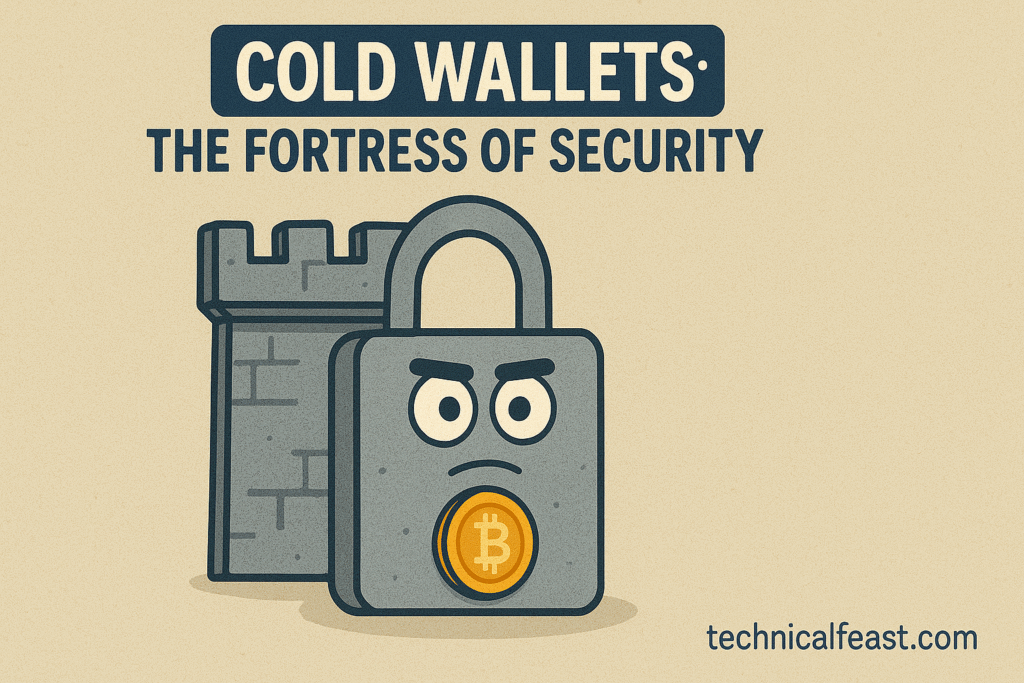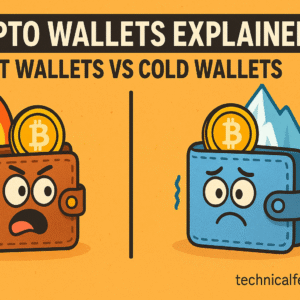Table of Contents
Cryptocurrency wallets play a crucial role in the world of digital assets. Whether you’re a seasoned trader or a beginner, understanding how to secure your crypto holdings is vital for protecting your investments. In this guide, we’ll explain the two primary types of crypto wallets—hot wallets and cold wallets—and explore their advantages, risks, and ideal use cases.
What is a Crypto Wallet?
A crypto wallet is essentially a digital tool that allows you to store, send, and receive cryptocurrencies like Bitcoin, Ethereum, and others. Unlike traditional wallets, which hold physical currency, crypto wallets store private keys—essential pieces of data that prove ownership of the digital currency. Without these keys, your crypto is essentially locked and inaccessible.
There are two main types of wallets: hot wallets and cold wallets. These two wallet categories offer different levels of security, accessibility, and convenience, making them suitable for different kinds of crypto users.
Hot Wallets: Always Connected, Always Accessible
A hot wallet refers to a cryptocurrency wallet that is connected to the internet. Hot wallets are extremely convenient because they allow users to quickly access and manage their digital assets. These wallets come in several forms, including mobile apps, desktop applications, and web-based platforms.
Advantages of Hot Wallets:
- Instant Access: Hot wallets enable immediate access to your cryptocurrency for trading, transferring, or spending.
- User-Friendly: They are typically easy to use and suitable for beginners or those who want to keep their funds in liquid form.
- Multi-Currency Support: Many hot wallets support a wide variety of cryptocurrencies, making them versatile for users with diverse portfolios.
However, with convenience comes risk. Since hot wallets are connected to the internet, they are more vulnerable to hacking, phishing, and malware attacks.
Real-World Example:
Imagine you’re a crypto trader who frequently buys and sells coins. You use a hot wallet to access your assets on exchanges like Binance or Coinbase. One day, a hacker exploits a vulnerability in the exchange’s security, and your funds are stolen. While this scenario is unfortunate, it highlights the primary downside of hot wallets: they are susceptible to online threats.
Common Hot Wallets:
- Exodus: A popular desktop and mobile wallet with a built-in exchange.
- MetaMask: A browser-based wallet primarily used for interacting with Ethereum and ERC-20 tokens.
- Coinbase Wallet: A mobile wallet that integrates seamlessly with the Coinbase exchange.
Cold Wallets: The Fortress of Security

A cold wallet, on the other hand, is not connected to the internet, offering a higher level of security. Cold wallets are ideal for long-term storage of cryptocurrencies, especially for users who are not making regular transactions. Since they are offline, they are immune to online hacking attempts.
Advantages of Cold Wallets:
- Enhanced Security: Because cold wallets are offline, they are far less vulnerable to cyberattacks and hacking attempts.
- Long-Term Storage: Cold wallets are perfect for users who want to hold their cryptocurrencies for an extended period without worrying about constant exposure to online threats.
- Ownership Control: With cold wallets, you maintain complete control over your private keys, reducing the risk of third-party breaches.
However, cold wallets can be inconvenient for regular transactions, as accessing them requires more steps and physical involvement.
Real-World Example:
Suppose you’re an investor who purchased Bitcoin when the price was low and plans to hold it for several years. You opt for a cold wallet to store your Bitcoin securely, knowing that even if someone compromises an online exchange, your funds remain safe offline.
Common Cold Wallets:
- Ledger Nano S/X: A hardware wallet known for its strong security and multi-currency support.
- Trezor Model T: Another well-regarded hardware wallet, offering advanced features and a user-friendly interface.
- Paper Wallets: A simple offline wallet solution that involves printing out your private keys and storing them in a secure location.
Hot Wallets vs Cold Wallets: Key Differences
| Feature | Hot Wallets | Cold Wallets |
|---|---|---|
| Connection | Always connected to the internet | Not connected to the internet |
| Security | Vulnerable to online attacks | Highly secure against online threats |
| Convenience | Easy to access and use | Less convenient, requires physical access |
| Ideal Use Case | Daily transactions and trading | Long-term storage and large holdings |
Which One Should You Choose?
The choice between a hot wallet and a cold wallet depends on your needs as a crypto user. If you’re an active trader who frequently buys and sells cryptocurrencies, a hot wallet is likely your best option. It provides quick access and is designed for high-frequency transactions.
On the other hand, if you’re an investor who prefers to hold your crypto assets for a long time without needing to access them regularly, a cold wallet is the more secure choice. Cold wallets are perfect for “HODLing” your assets until you’re ready to sell.
Best Practices for Securing Your Crypto Wallet
Regardless of whether you choose a hot wallet or a cold wallet, it’s essential to follow best practices for securing your crypto assets:
- Enable Two-Factor Authentication (2FA): Whether you’re using a hot or cold wallet, always enable 2FA to add an extra layer of protection.
- Use Strong Passwords: Avoid using easy-to-guess passwords. Make sure your wallet password is unique and difficult to crack.
- Backup Your Keys: For cold wallets, it’s crucial to back up your private keys in multiple secure locations. Never store them on your computer or online.
- Update Software Regularly: For hot wallets, ensure your software is up to date with the latest security patches.
Frequently Asked Questions (FAQs)
1. Are hot wallets safe?
While hot wallets are convenient, they are more vulnerable to hacking and phishing attacks due to their constant connection to the internet. To increase security, enable two-factor authentication and only store small amounts of crypto in hot wallets.
2. Can cold wallets be hacked?
Cold wallets are far more secure than hot wallets because they are offline. However, if someone gains physical access to your cold wallet, they could steal your assets. Always store your cold wallet in a secure location.
3. Should I use both hot and cold wallets?
Many crypto users choose to use both hot and cold wallets. A common strategy is to store a small amount of crypto in a hot wallet for easy access, while keeping the majority of funds in a cold wallet for long-term security.
4. What is the best hot wallet?
The best hot wallet depends on your needs. Popular choices include MetaMask for Ethereum users and Coinbase Wallet for those using a variety of cryptocurrencies. Ensure that the wallet you choose offers strong security features and user-friendly design.
Conclusion
Understanding the differences between hot wallets and cold wallets is essential for anyone dealing with cryptocurrency. While hot wallets offer convenience and accessibility for active traders, cold wallets provide a higher level of security for long-term investors. By choosing the right wallet for your needs and following best security practices, you can safeguard your digital assets and enjoy peace of mind.




Leave a Reply